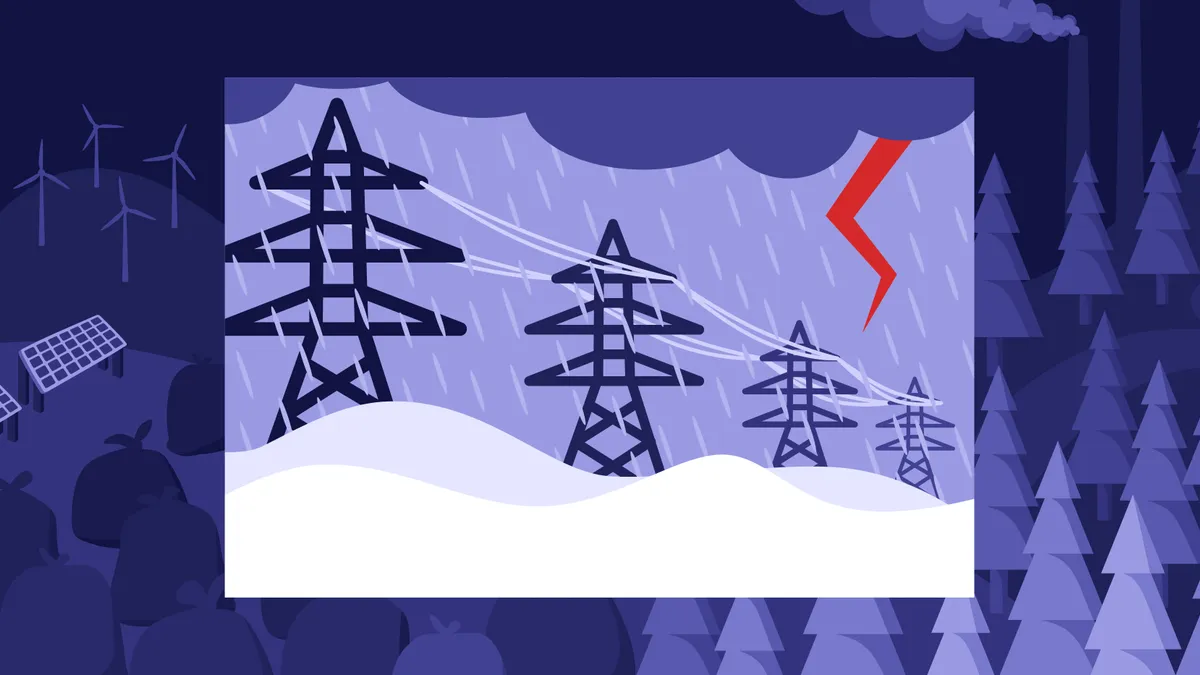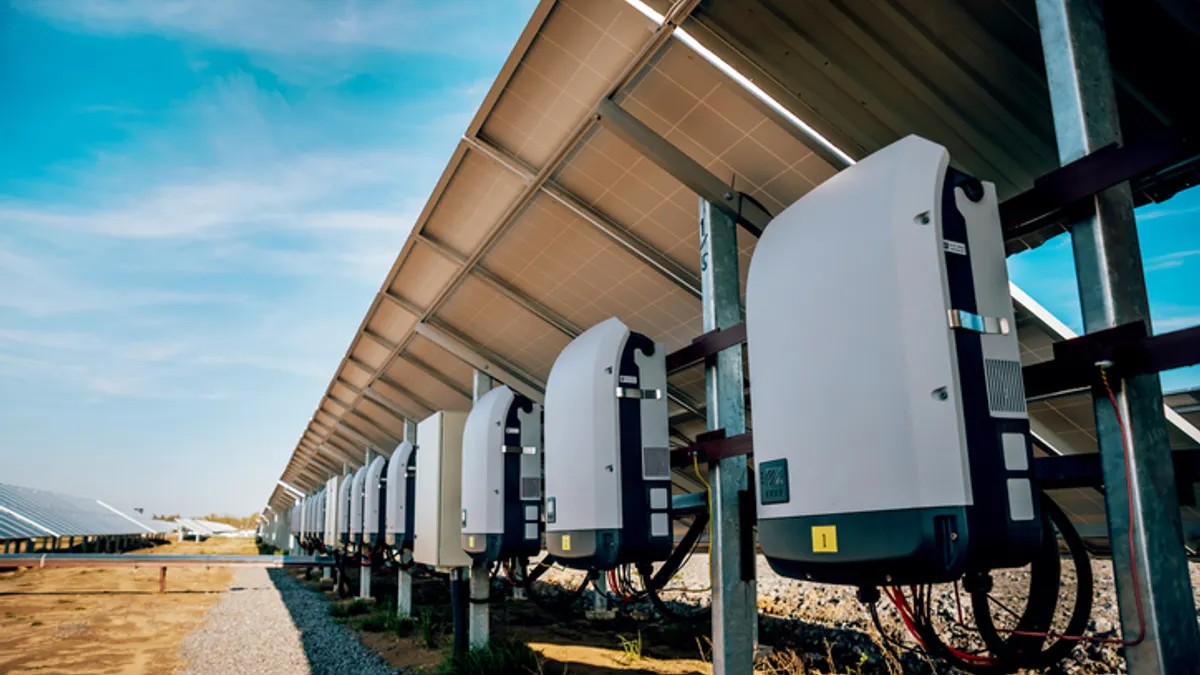This article is part of a series on the way the utility and waste and recycling industries are accounting for climate change.
Many nuclear and fossil fuel power plants in the U.S. are intentionally sited near a body of water to provide access for various cooling processes while much electrical infrastructure remains above ground, according to the Energy Information Administration. The location of these assets makes them vulnerable to the intensifying impacts of the storms, hurricanes and flooding that have occurred with rising frequency over the past two decades, experts say.
On the Gulf Coast, for instance, companies need to expect what was previously a once-in-100 year severe rain event to now happen once every three years, per an analyst at global management consulting firm McKinsey & Company.
"The probability of the extreme weather events has increased quite markedly,” said Matt Rogers, senior partner at McKinsey.
Within voluntary filings for the CDP, 13 out of 18 U.S. utility respondents examined by Utility Dive identified a physical risk of extreme weather events such as "floods or cyclones." When estimating the cost of these increasing storms, some utilities tried using recent storm damage as a benchmark for what could be expected: multiplying the costs of damage from a specific storm for the next decade. Utilities sometimes use the costs of storms from the most impactful storms in recent years to forecast damage.
For example, Duke Energy multiplied the damage caused by Hurricane Michael and Florence tenfold to estimate the impact from storms over the next decade, according to its CDP filing. NRG Energy, with one of of its two headquarters in Houston, Texas, used the damage from Hurricane Harvey to benchmark the potential impact of storms on its assets.
As utilities acknowledge increasing climate risks in their financial filings or through voluntary questionnaires, such as CDP's, interest from investors and capital markets in financing utility mitigation efforts has not waned.
Capital markets not shying away from financing climate impacts
Utilities are not having trouble accessing the capital markets to secure financing for recovery and resilience initiatives despite their increasing vulnerability to climate risks because they are considered a reliable investment asset, analysts say.
"As far as the capital markets, everybody’s aware that there’s climate change,” said Tim Hynes, head of North American research for Debtwire. "The market knows that there’s climate change risk but they’re still willing to provide financing.”
In anticipation of the costs of major hurricane seasons or other worsening natural disasters, utilities can raise additional debt and equity capital, per Debtwire.
Utilities have raised 90% more equity in 2020 than they did in 2019, and also increased the amount of convertible bonds raised 15% between those same years. Several of the utilities involved did so during seasons when extreme weather events were expected, from hurricanes to wildfires, Hynes said, such as Liberty Utilities' parent company, Algonquin Power & Utilities, and Eversource Energy.
"The markets… are still allowing utilities to raise money despite the environmental risk,” Hynes said, even with the ongoing public health crisis of COVID-19.
Even with debt-equity markets "basically closed during the entire month of March,” due to COVID-19, utilities still raised a materially larger amount of money than they did the year prior, which they can use for plant improvements and in case a major weather event occurs, Hynes said.
While larger investor-owned utilities have a bigger balance sheet to increase their spending power, smaller utilities and energy companies also use their capital plans to address resiliency and recovery, Hynes said.
The New York Power Authority, for instance, has "an extensive capital plan governed by an aggressive asset management strategy," including nearly $500 million of resilience-related projects in progress, to mitigate transmission reliability concerns and other threats, according to a utility spokesperson.
The plans for financing resiliency and recovery are already integrated into utility planning and investments, according to utility industry group Edison Electric Institute (EEI).
"There are all sorts of threats to operations of the grid that being able to prepare to mitigate and ultimately to respond and recover is sort of woven into the investment strategies and the infrastructure upgrades that all of our companies are making," said Scott Aaronson, EEI's vice president of security and preparedness.
No universal 'plug' for climate change 'leaks'
Having linked a variety of challenges to climate change, utilities continue to invest in comprehensively addressing these threats.
Extreme weather risks for utilities are regionally specific, but certain concerns can overlap, requiring precise forecasting to address different threats.
For example, "putting things underground when the risk is [also] river flooding, turns out to be a bad idea," McKinsey's Rogers said, leading utilities that face both hurricanes and flooding to address some infrastructure through potentially more expensive hardening approaches above ground.
Energy companies therefore pursue very nuanced strategies to protecting their infrastructure. Priorities for hardening efforts by utilities may include upgrades at the transmission level and at substation facilities, "particularly critical" for a large portion of the country, EEI's Aaronson said. Companies ave already identified those facilities, he added, and prepare accordingly by having spare equipment, contingency plans to operate without them, and other such considerations.
"I think the tools and methodologies for being able to forecast extreme events, down to relatively precise levels, has improved dramatically over one decade. We now have much better tools to allow a utility to begin to model out” those risks, Rogers said.
In addition to better forecasting, targeted grid hardening can also be efficient and is being prioritized by utilities and regulators alike.
Oftentimes, McKinsey estimates that strategically hardening only 15% to 20% of a utility's grid system makes it dramatically safer.
"It's figuring out where those vulnerability points are and putting the investment there that turns out to be the highest return for customers in that process,” Rogers said. "The key response is reasonably different depending on where you are and what kind of threat you’re facing locally.”
Investor-owned utilities remain confident in the grid's resiliency, based on past experiences rerouting power in the middle of an incident. "The industry has a very good feel for what our highest priority is," Aaronson said.
Smoke on the water?
Flooding concerns are taken seriously in the energy sector based on the proximity of U.S. generation to bodies of water.
Changing patterns related to weather events such as increases in rainfall and hurricane frequency have driven a greater need for accurate forecasting across utility transmission, distribution and generation assets, as utilities can no longer rely on historical information, experts say.
Many climate forecast models predict sea-level rise, as McKinsey & Company notes, which creates inherent risk for energy generation, as many power plants were deliberately built near shorelines for access to water.
Rising sea levels are a concern for many utilities with coastal facilities. Pacific Gas & Electric and Entergy specifically outlined it as a standalone physical risk in their CDP filings, though neither utility has an estimate for the cost of the impact.
Concerns have been raised about the potential impact of rising sea levels on nuclear plants in particular, analysts say. Per McKinsey, nine nuclear power plants in the U.S. are located within two miles of the ocean.
But nuclear generators have been working to address any doubts about the resilience of the resource. The Nuclear Regulatory Commission previously prompted an evaluation of the climate risks related to climate change, including flooding. The evaluation led to a series of hardening measures, trainings and other protocols regarding extreme weather events for nuclear generators to implement.
"The nuclear industry is heavily regulated whereas the other infrastructure is much less so, and so by definition the nuclear plants are required to plan for extremely severe external hazards, such as weather events, than are accounted for by any other U.S. infrastructure," said Jennifer Uhle, vice presidnet of generation and suppliers for the Nuclear Energy Institute.
Too little water can also threaten power infrastructure, as coal, gas and nuclear plants rely on a steady flow to cool their generators. Scientists warn that a warmer climate will exacerbate drought conditions in many regions, putting those plants at risk. Duke Energy lists several plants at risk of extreme drought events, including a nuclear facility in North Carolina.
"Generation facilities... are not a particularly high priority," compared to other grid hardening measures, according to EEI's Aaronson, as there is capacity in the system to deal with generators coming offline.
"On the generation side, there could be failures in bulk systems, but usually there is already contingency preparedness," according to AutoGrid's general manager/VP of new energy Rahul Kar.
Hydropower facilities are also sensitive to changes in water precipitation for overall output and generation efficiency, whether facing drought conditions or oversupply.
For example, as part of NYPA's ongoing projects to improve resilience, NYPA is automating controls for the gate operation of its hydro-generating facility. "During winter and other high-water conditions, the ability to remotely control the spilling of water at hydro facilities will become even more important," the company said in an e-mail.
Regulators, legislators ramp up focus on resiliency
The threat of worsening hurricanes, storms and flooding has led not just utilities, but regulators and legislators to focus on resiliency solutions.
Pacific Gas & Electric's recent bankruptcy is often used as an example for the impact that worsening wildfires can have on a utility. But Puerto Rico's electric grid suffered a large amount of damage in the 2017 hurricane season, when Hurricane Irma and Hurricane Maria destroyed access to electricity on much of the island. That seminal moment of extreme impact set the state's energy board and utility commissioners to rethink resiliency on the island, including a shift away from burning fossil fuels and an approach that involves several "mini grids."
Resiliency spending has increased among utilities, and states, regulators and other stakeholders are scrutinizing the effectiveness of those investments. In Florida, where utilities have had to contend with extreme heat and rising energy demand during active hurricane seasons, state legislators authorized nearly $20 billion for utilities to harden the grid against hurricanes after lengthy recovery efforts in the 2004 and 2005 hurricane seasons. Regulators compared those storm-related outages to the shorter outages during four hurricanes that occurred in 2016-2017, deeming the storm hardening from utilities 'effective.'
The legislature focused on undergrounding infrastructure due to hurricanes, while waterproofing a set of substation processes and equipment where flooding events pose a greater threat, which McKinsey’s Rogers sees as a way to respond to multiple physical risks tied to climate change.
In New York, the state energy agency, the grid operator, and participating utilities are conducting a climate resilience study focused on the impacts of hurricanes, storms, sea level rise and flooding. The efforts are underpinned by decarbonization goals that Gov. Andrew Cuomo established for the state, including efforts to add large amounts of energy storage and new renewable assets, such as offshore wind.
"[G]rid scale battery storage deployment in the State of New York is essential to ensure the grid can ride through disruptive events such as storms," according to NYPA.
However, as regulators authorize more spending for utilities, storm response is being judged and critiqued as utilities react to recent storms. Hurricane Isaias, which affected the Atlantic Coast this summer, led New York and Connecticut governors to criticize utilities for what the governors considered an inadequate response.
Eversource Energy, the largest utility in Connecticut, had implemented a $300 million five-year resilience plan in 2013, received a $124.6 million rate hike in April 2018 for system resiliency through 2020, and filed with state regulators to extend vegetation management programs into 2021 and 2022. However, for all the resiliency spending, energy recovery from Isaias went slowly as many customers lost power. This begs the question of how utility resiliency spending decisions are made and might attract larger scrutiny in the future, according to John Hodges, vice president of Business for Social Responsibility.
"I would hate to work for a utility when the power does go out for an extended period of time because of a weather event," he said. "I think maybe when the regulators get more heavily involved, the regulators will start actually putting pressure on them," to make it clear that outages will impact a regulated utility's bottom line.























